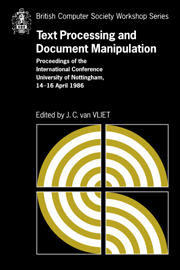 Text Processing and Document Manipulation
Text Processing and Document Manipulation Book contents
- Frontmatter
- Contents
- Preface
- The Design of Lucida®: an Integrated Family of Types for Electronic Literacy
- Tabular Typography
- A Simple Mechanism for Authorship of Dynamic Documents
- VORTEXT: VictORias TEXT reading and authoring system
- An Approach to the Design of a Page Description Language
- Intelligent Matching and Retrieval for Electronic Document Manipulation
- A Disciplined Text Environment
- Semantic Guided Editing: A Case Study On Genetic Manipulations
- Trends and Standards in Document Representation
- Textmaster – document filing and retrieval using ODA
- Combining Interactive Document Editing with Batch Document Formatting
- Formatting Structure Documents: Batch versus Interactive?
- Advanced Catalogue Production at Unipart
- Legibility of Digital Type-fonts and Comprehension in Reading
- An Overview of the W Document Preparation System
- Grif: An Interactive System for Structured Document Manipulation
- Procedural Page Description Languages
- A Strategy for Compressed Storage and Retrieval of Documents
- CONCEPT BROWSER: a System for Interactive Creation of Dynamic Documentation
- An Integrated, but not Exact-Representation, Editor/Formatter
- An Annotated Bibliography on Document Processing
- Systems used
Trends and Standards in Document Representation
Published online by Cambridge University Press: 05 May 2010
- Frontmatter
- Contents
- Preface
- The Design of Lucida®: an Integrated Family of Types for Electronic Literacy
- Tabular Typography
- A Simple Mechanism for Authorship of Dynamic Documents
- VORTEXT: VictORias TEXT reading and authoring system
- An Approach to the Design of a Page Description Language
- Intelligent Matching and Retrieval for Electronic Document Manipulation
- A Disciplined Text Environment
- Semantic Guided Editing: A Case Study On Genetic Manipulations
- Trends and Standards in Document Representation
- Textmaster – document filing and retrieval using ODA
- Combining Interactive Document Editing with Batch Document Formatting
- Formatting Structure Documents: Batch versus Interactive?
- Advanced Catalogue Production at Unipart
- Legibility of Digital Type-fonts and Comprehension in Reading
- An Overview of the W Document Preparation System
- Grif: An Interactive System for Structured Document Manipulation
- Procedural Page Description Languages
- A Strategy for Compressed Storage and Retrieval of Documents
- CONCEPT BROWSER: a System for Interactive Creation of Dynamic Documentation
- An Integrated, but not Exact-Representation, Editor/Formatter
- An Annotated Bibliography on Document Processing
- Systems used
Summary
ABSTRACT
This paper starts by tracing the architecture of document preparation systems. Two basic types of document representations appear : at the page level or at logical level. The paper then focuses on logical level representations and tries to survey three existing formalisms : SGML, Interscript and ODA.
Introduction
Document preparation systems might be now the most commonly used computer systems, ranging from stand-alone text processing individual machines to highly sophisticated systems running on mainframe computers. All of those systems internally use a more or less formal system for representing documents. Document representation formalisms are very different according to their goals. Some of them define the interface with the printing device, they are oriented towards a precise geometric description of the contents of each page in a document. Others are used internally in systems as a memory representation. Yet others have to be learned by users ; they are symbolic languages used to control document processing.
The trouble is that there are today nearly as many representation formalisms as document preparation systems. This makes it nearly impossible, first to interchange documents among heterogeneous systems, second to have standard programming interfaces for developping systems. Standardization organizations and large companies are now trying to establish standards in the field in order to stop proliferation of formalisms and facilitate document interchange.
This paper focuses in the last sections on three document representation formalisms often called ‘revisable formats’, namely SGML [SGML], ODA [ODA], and Interscript [Ayers & al.], [Joloboff & al.]. In order to better understand what is a revisable format, the paper starts with a look at the evolution of the architecture of document preparation systems.
- Type
- Chapter
- Information
- Text Processing and Document ManipulationProceedings of the International Conference, University of Nottingham, 14-16 April 1986, pp. 107 - 124Publisher: Cambridge University PressPrint publication year: 1986
- 5
- Cited by


